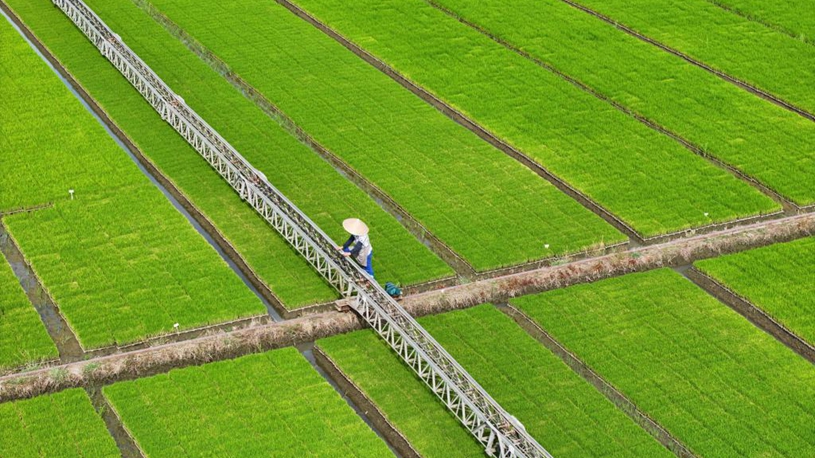China's new satellite industry city takes shape with ground station project approved
Source: Xinhua
Editor: huaxia
2025-06-06 21:58:15
CHENGDU, June 6 (Xinhua) -- A new satellite industry city is taking shape in southwest China's Sichuan Province, following the approval of a commercial satellite ground station project in Meishan, which is working to become a new powerhouse of the industry in China.
The newly approved project, the largest of its kind in Sichuan, marked a critical step in advancing the region's aerospace ecosystem and promoting the country's development of commercial satellite networks as well, Yang Zhenyu, deputy general manager of the Huantian Wisdom Technology Co., Ltd., owner of the new infrastructure, told Xinhua on Friday.
"It is expected to complete the last piece of Meishan's aerospace industry layout, making the city one of the few places in China with comprehensive capabilities in satellite research and development, monitoring and control, application, and data transmission," he said.
The ground station, covering 872 square meters near a local reservoir, will feature a 12-meter-diameter antenna and auxiliary facilities.
Its construction is scheduled to commence in mid-June, with an anticipated completion date in the third quarter of this year, followed by official operations by year-end, said Yang.
"This infrastructure is pivotal for satellite operations," he said.
It aims to address data transmission bottlenecks by enabling autonomous tracking, telemetry, and command for the Huantian Constellation satellites, a major commercial satellite constellation in China for agricultural monitoring, ecological protection and smart city construction, ending the area's reliance on leased external stations, he explained.
Once operational, the ground station will significantly enhance the satellite's data transmission and reception capabilities and stability, he said.
MEISHAN'S PLAN
In the past three decades, China's space industry has rapidly advanced, marked by the launch of landmark space missions such as Shenzhou and Chang'e. As a result, numerous cities known for their related industries have popped up across the country.
In the realm of satellite technology, regions beyond traditional strongholds like Beijing, Shanghai, and Xi'an are now making significant strides in this sector, particularly in commercial satellites. Cities such as Meishan have emerged as new hubs for the satellite industry.
Yang noted that once established, the ground station can not only reduce data usage costs for local enterprises but also attract supporting projects from upstream and downstream sectors. This will help to further expand the "satellite plus" industrial cluster in Meishan, which is just about 70 kilometers away from the provincial capital of Chengdu.
The city now hosts a satellite industrial park, a satellite monitoring and control center and 10 high-resolution optical satellites under Huantian Constellation's phase 1.
Meishan unveiled its satellite industry development plan (2024-2030) last year, outlining a strategic roadmap to build a globally competitive satellite industry cluster by 2030, targeting an industrial scale exceeding 10 billion yuan (about 1.39 billion U.S. dollars).
Leveraging the Huantian Constellation project as its cornerstone, the city will drive integrated development across satellite applications, operations, manufacturing, and experimental launch capabilities.
Key tasks include diversifying satellite applications, enhancing ground system capabilities, developing satellite assembly integration, and exploring innovative aerospace information technologies, according to the plan.
VISION OF THE CONSTELLATION
Launched in 2022, the Huantian Constellation orbits 535 km above Earth, capturing over 1 TB daily data, equivalent to 200,000 HD images, and covering 70 million square kilometers globally with a 120-minute revisit capability, according to Yang.
Leveraging its "sky-air-ground" service framework, the company has driven breakthroughs in farmland monitoring, ecological protection, and disaster prevention. In 2024, it reported revenue of 430 million yuan and profits of 36 million yuan, surging 30 percent and 20 percent year-on-year, respectively, he said.
Last year, as the leader of the satellite industrial park in west China, Huantian Wisdom led the establishment of a commercial satellite alliance. This allowed for the integration of 148 satellites nationwide, expediting the development of the industrial cluster and uniting the satellite industry with the low-altitude economy.
"We plan to launch 10 more satellites this year," Yang said.
Looking ahead, the satellite constellation plans to expand to 30 to 50 satellites in phase 2, further enhancing data acquisition and global revisit efficiency, said Yang, adding that their long-term goals include integrating 6G, AI, and space-ground fusion tech to build smart commercial platforms and advance low-altitude economy applications. ■













Comments